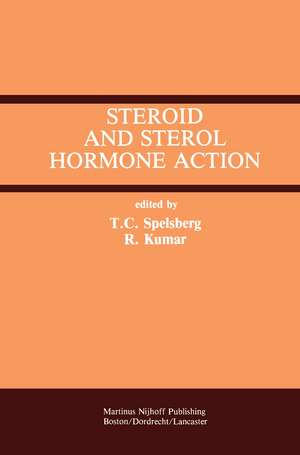Steroid and Sterol Hormone Action
Editat de Thomas C. Spelsberg, Rajiv Kumaren Limba Engleză Paperback – 20 sep 2011
| Toate formatele și edițiile | Preț | Express |
|---|---|---|
| Paperback (1) | 1417.38 lei 6-8 săpt. | |
| Springer Us – 20 sep 2011 | 1417.38 lei 6-8 săpt. | |
| Hardback (1) | 1424.52 lei 6-8 săpt. | |
| Springer Us – 29 iun 1987 | 1424.52 lei 6-8 săpt. |
Preț: 1417.38 lei
Preț vechi: 1491.99 lei
-5% Nou
Puncte Express: 2126
Preț estimativ în valută:
271.20€ • 283.19$ • 223.96£
271.20€ • 283.19$ • 223.96£
Carte tipărită la comandă
Livrare economică 15-29 aprilie
Preluare comenzi: 021 569.72.76
Specificații
ISBN-13: 9781461292302
ISBN-10: 1461292301
Pagini: 436
Ilustrații: XIV, 418 p.
Dimensiuni: 155 x 235 x 23 mm
Greutate: 0.61 kg
Ediția:Softcover reprint of the original 1st ed. 1987
Editura: Springer Us
Colecția Springer
Locul publicării:New York, NY, United States
ISBN-10: 1461292301
Pagini: 436
Ilustrații: XIV, 418 p.
Dimensiuni: 155 x 235 x 23 mm
Greutate: 0.61 kg
Ediția:Softcover reprint of the original 1st ed. 1987
Editura: Springer Us
Colecția Springer
Locul publicării:New York, NY, United States
Public țintă
ResearchDescriere
The purpose of this book is to focus attention on recent developments in steroid and sterol hormone action. Many authors have generously contributed to the book. As a result, there is a great diversity of opinion! A majority of the chapters deal with steroid or sterol hormone receptors. This is not meant to imply that receptor-mediated mechanisms are the sole or even the most important mechanisms by which steroid hormones act in the cell. There is wealth of evidence showing that other, non-receptor events, are important also. Steroid hormone recep tor research and the study of nuclear events mediated by steroids are presently the most intensely studied aspects of sterol hormone action and our selection of topics reflects this trend. We have also included chapters on vitamin 0 sterols and thyroid hormone in the book, as there is pood evidence that these hormones act in a manner similar to other classical steroids. 1 IMMUNOCHARACTERIZATION OF THE NUCLEAR ACCEPTOR SITES FOR THE AVIAN OVIDUCT PROGESTERONE RECEPTOR A. GOLDBERGER, M. HORTON, T. C. SPELSBERG Department of Biochemistry and Molecular Biology, Mayo Clinic and Mayo Graduate School of Medicine, Rochester, MN 55905 INTRODUCTION It is well known that steroid hormones, certain vitamins and sterols, enter target cells and bind to specific protein receptors in the cyto plasm or nucleus (1-4). This binding is saturable, high affinity, and steroid specific.
Cuprins
1. Immunocharacterization of the nuclear acceptor sites for the avian oviduct progesterone receptor.- 2. Immunological analysis of the avian progesterone receptor.- 3. Purification, structure and function of the chick oviduct progesterone receptor: remaining questions in 1986.- 4. Novel mechanisms for regulation of mammalian estrogen and progesterone receptors.- 5. Hormones and oncogenes in human breast cancer.- 6. Estrogen control of vitellogenin gene transcription and mRNA stability.- 7. Nuclear acceptor sites for the mammalian estrogen receptor: effects of antiestrogens.- 8. Phosphorylation reactions associated with the glucocorticoid receptor.- 9. Structure and function of cytosolic glucocorticoid receptors in WEHI-7 mouse thymoma cells: receptor composition and phosphorylation.- 10. Inhibition of glucocorticoid receptor conversion to the DNA-binding state and inhibition of subunit dissociation.- 11. Glucocorticoid regulation of proto-oncogene expression and cellular proliferation.- 12. Steroid regulation of rRNA synthesis.- 13. Variations in agonist activity among antiglucocorticoid steroids and its relation to glucocorticoid regulated genes.- 14. On the mechanism of action of aldosterone.- 15. Regulation of epithelial Na+ transport by aldosterone.- 16. Messenger RNA-S14 as a model of thyroid hormone action at the hepatocellular level.- 17. The 1,25-Dihydroxycholecalciferol receptor.- 18. Receptors for 1,25-dihydroxyvitamin D3: Structural comparisons and recent functional insights.- 19. Vitamin D-dependent calcium-binding protein gene: cDNA cloning, mRNA distribution and regulation in the rat.- 20. The physiology and biochemistry of vitamin D-dependent calcium binding proteins.- 21. The oxysterol receptor.








